Hou Pong Chan
FINEREASON: Evaluating and Improving LLMs' Deliberate Reasoning through Reflective Puzzle Solving
Feb 27, 2025Abstract:Many challenging reasoning tasks require not just rapid, intuitive responses, but a more deliberate, multi-step approach. Recent progress in large language models (LLMs) highlights an important shift from the "System 1" way of quick reactions to the "System 2" style of reflection-and-correction problem solving. However, current benchmarks heavily rely on the final-answer accuracy, leaving much of a model's intermediate reasoning steps unexamined. This fails to assess the model's ability to reflect and rectify mistakes within the reasoning process. To bridge this gap, we introduce FINEREASON, a logic-puzzle benchmark for fine-grained evaluation of LLMs' reasoning capabilities. Each puzzle can be decomposed into atomic steps, making it ideal for rigorous validation of intermediate correctness. Building on this, we introduce two tasks: state checking, and state transition, for a comprehensive evaluation of how models assess the current situation and plan the next move. To support broader research, we also provide a puzzle training set aimed at enhancing performance on general mathematical tasks. We show that models trained on our state checking and transition data demonstrate gains in math reasoning by up to 5.1% on GSM8K.
M-Longdoc: A Benchmark For Multimodal Super-Long Document Understanding And A Retrieval-Aware Tuning Framework
Nov 09, 2024Abstract:The ability to understand and answer questions over documents can be useful in many business and practical applications. However, documents often contain lengthy and diverse multimodal contents such as texts, figures, and tables, which are very time-consuming for humans to read thoroughly. Hence, there is an urgent need to develop effective and automated methods to aid humans in this task. In this work, we introduce M-LongDoc, a benchmark of 851 samples, and an automated framework to evaluate the performance of large multimodal models. We further propose a retrieval-aware tuning approach for efficient and effective multimodal document reading. Compared to existing works, our benchmark consists of more recent and lengthy documents with hundreds of pages, while also requiring open-ended solutions and not just extractive answers. To our knowledge, our training framework is the first to directly address the retrieval setting for multimodal long documents. To enable tuning open-source models, we construct a training corpus in a fully automatic manner for the question-answering task over such documents. Experiments show that our tuning approach achieves a relative improvement of 4.6% for the correctness of model responses, compared to the baseline open-source models. Our data, code, and models are available at https://multimodal-documents.github.io.
VisAidMath: Benchmarking Visual-Aided Mathematical Reasoning
Oct 30, 2024Abstract:Although previous research on large language models (LLMs) and large multi-modal models (LMMs) has systematically explored mathematical problem-solving (MPS) within visual contexts, the analysis of how these models process visual information during problem-solving remains insufficient. To address this gap, we present VisAidMath, a benchmark for evaluating the MPS process related to visual information. We follow a rigorous data curation pipeline involving both automated processes and manual annotations to ensure data quality and reliability. Consequently, this benchmark includes 1,200 challenging problems from various mathematical branches, vision-aid formulations, and difficulty levels, collected from diverse sources such as textbooks, examination papers, and Olympiad problems. Based on the proposed benchmark, we conduct comprehensive evaluations on ten mainstream LLMs and LMMs, highlighting deficiencies in the visual-aided reasoning process. For example, GPT-4V only achieves 45.33% accuracy in the visual-aided reasoning task, even with a drop of 2 points when provided with golden visual aids. In-depth analysis reveals that the main cause of deficiencies lies in hallucination regarding the implicit visual reasoning process, shedding light on future research directions in the visual-aided MPS process.
SeaLLMs 3: Open Foundation and Chat Multilingual Large Language Models for Southeast Asian Languages
Jul 29, 2024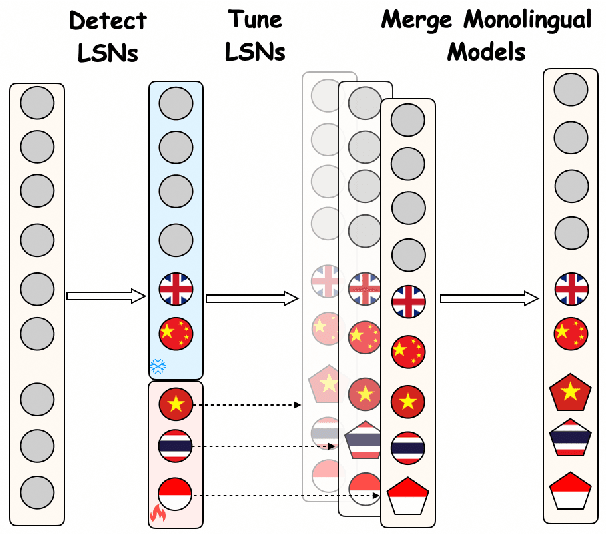
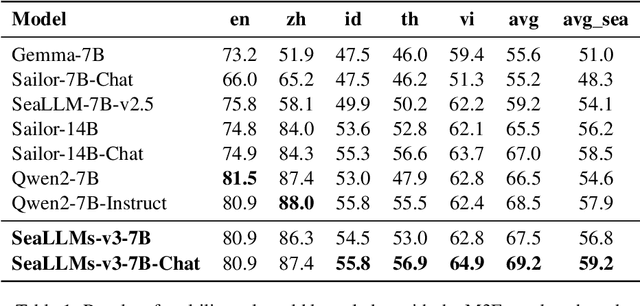
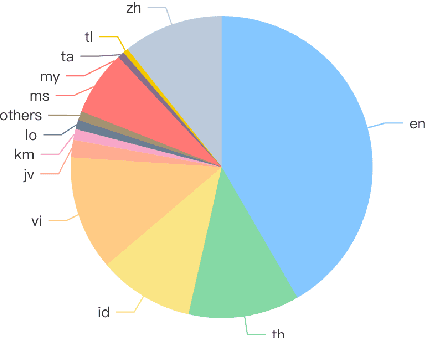
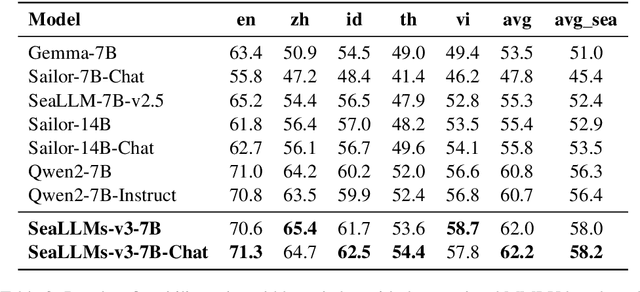
Abstract:Large Language Models (LLMs) have shown remarkable abilities across various tasks, yet their development has predominantly centered on high-resource languages like English and Chinese, leaving low-resource languages underserved. To address this disparity, we present SeaLLMs 3, the latest iteration of the SeaLLMs model family, tailored for Southeast Asian languages. This region, characterized by its rich linguistic diversity, has lacked adequate language technology support. SeaLLMs 3 aims to bridge this gap by covering a comprehensive range of languages spoken in this region, including English, Chinese, Indonesian, Vietnamese, Thai, Tagalog, Malay, Burmese, Khmer, Lao, Tamil, and Javanese. Leveraging efficient language enhancement techniques and a specially constructed instruction tuning dataset, SeaLLMs 3 significantly reduces training costs while maintaining high performance and versatility. Our model excels in tasks such as world knowledge, mathematical reasoning, translation, and instruction following, achieving state-of-the-art performance among similarly sized models. Additionally, we prioritized safety and reliability by addressing both general and culture-specific considerations and incorporated mechanisms to reduce hallucinations. This work underscores the importance of inclusive AI, showing that advanced LLM capabilities can benefit underserved linguistic and cultural communities.
Unlocking Varied Perspectives: A Persona-Based Multi-Agent Framework with Debate-Driven Text Planning for Argument Generation
Jun 28, 2024
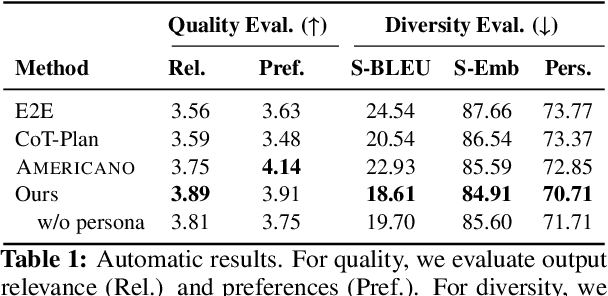
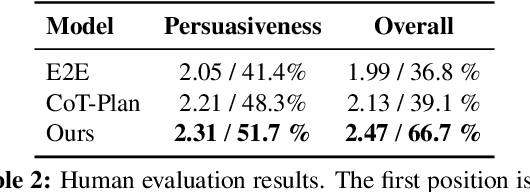
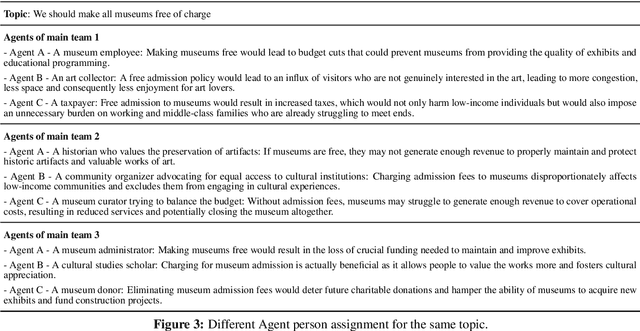
Abstract:Writing persuasive arguments is a challenging task for both humans and machines. It entails incorporating high-level beliefs from various perspectives on the topic, along with deliberate reasoning and planning to construct a coherent narrative. Current language models often generate surface tokens autoregressively, lacking explicit integration of these underlying controls, resulting in limited output diversity and coherence. In this work, we propose a persona-based multi-agent framework for argument writing. Inspired by the human debate, we first assign each agent a persona representing its high-level beliefs from a unique perspective, and then design an agent interaction process so that the agents can collaboratively debate and discuss the idea to form an overall plan for argument writing. Such debate process enables fluid and nonlinear development of ideas. We evaluate our framework on argumentative essay writing. The results show that our framework can generate more diverse and persuasive arguments through both automatic and human evaluations.
From Pixels to Insights: A Survey on Automatic Chart Understanding in the Era of Large Foundation Models
Mar 25, 2024Abstract:Data visualization in the form of charts plays a pivotal role in data analysis, offering critical insights and aiding in informed decision-making. Automatic chart understanding has witnessed significant advancements with the rise of large foundation models in recent years. Foundation models, such as large language models, have revolutionized various natural language processing tasks and are increasingly being applied to chart understanding tasks. This survey paper provides a comprehensive overview of the recent developments, challenges, and future directions in chart understanding within the context of these foundation models. We review fundamental building blocks crucial for studying chart understanding tasks. Additionally, we explore various tasks and their evaluation metrics and sources of both charts and textual inputs. Various modeling strategies are then examined, encompassing both classification-based and generation-based approaches, along with tool augmentation techniques that enhance chart understanding performance. Furthermore, we discuss the state-of-the-art performance of each task and discuss how we can improve the performance. Challenges and future directions are addressed, highlighting the importance of several topics, such as domain-specific charts, lack of efforts in developing evaluation metrics, and agent-oriented settings. This survey paper serves as a comprehensive resource for researchers and practitioners in the fields of natural language processing, computer vision, and data analysis, providing valuable insights and directions for future research in chart understanding leveraging large foundation models. The studies mentioned in this paper, along with emerging new research, will be continually updated at: https://github.com/khuangaf/Awesome-Chart-Understanding.
Persona-DB: Efficient Large Language Model Personalization for Response Prediction with Collaborative Data Refinement
Feb 16, 2024Abstract:The increasing demand for personalized interactions with large language models (LLMs) calls for the development of methodologies capable of accurately and efficiently identifying user opinions and preferences. Retrieval augmentation emerges as an effective strategy, as it can accommodate a vast number of users without the costs from fine-tuning. Existing research, however, has largely focused on enhancing the retrieval stage and devoted limited exploration toward optimizing the representation of the database, a crucial aspect for tasks such as personalization. In this work, we examine the problem from a novel angle, focusing on how data can be better represented for more efficient retrieval in the context of LLM customization. To tackle this challenge, we introduce Persona-DB, a simple yet effective framework consisting of a hierarchical construction process to improve generalization across task contexts and collaborative refinement to effectively bridge knowledge gaps among users. In the task of response forecasting, Persona-DB demonstrates superior efficiency in maintaining accuracy with a significantly reduced retrieval size, a critical advantage in scenarios with extensive histories or limited context windows. Our experiments also indicate a marked improvement of over 15% under cold-start scenarios, when users have extremely sparse data. Furthermore, our analysis reveals the increasing importance of collaborative knowledge as the retrieval capacity expands.
Can LLMs Produce Faithful Explanations For Fact-checking? Towards Faithful Explainable Fact-Checking via Multi-Agent Debate
Feb 12, 2024



Abstract:Fact-checking research has extensively explored verification but less so the generation of natural-language explanations, crucial for user trust. While Large Language Models (LLMs) excel in text generation, their capability for producing faithful explanations in fact-checking remains underexamined. Our study investigates LLMs' ability to generate such explanations, finding that zero-shot prompts often result in unfaithfulness. To address these challenges, we propose the Multi-Agent Debate Refinement (MADR) framework, leveraging multiple LLMs as agents with diverse roles in an iterative refining process aimed at enhancing faithfulness in generated explanations. MADR ensures that the final explanation undergoes rigorous validation, significantly reducing the likelihood of unfaithful elements and aligning closely with the provided evidence. Experimental results demonstrate that MADR significantly improves the faithfulness of LLM-generated explanations to the evidence, advancing the credibility and trustworthiness of these explanations.
Do LVLMs Understand Charts? Analyzing and Correcting Factual Errors in Chart Captioning
Dec 15, 2023



Abstract:Recent advancements in large vision-language models (LVLMs) have led to significant progress in generating natural language descriptions for visual content and thus enhancing various applications. One issue with these powerful models is that they sometimes produce texts that are factually inconsistent with the visual input. While there has been some effort to mitigate such inconsistencies in natural image captioning, the factuality of generated captions for structured document images, such as charts, has not received as much scrutiny, posing a potential threat to information reliability in critical applications. This work delves into the factuality aspect by introducing a comprehensive typology of factual errors in generated chart captions. A large-scale human annotation effort provides insight into the error patterns and frequencies in captions crafted by various chart captioning models, ultimately forming the foundation of a novel dataset, CHOCOLATE. Our analysis reveals that even state-of-the-art models, including GPT-4V, frequently produce captions laced with factual inaccuracies. In response to this challenge, we establish the new task of Chart Caption Factual Error Correction and introduce CHARTVE, a model for visual entailment that outperforms proprietary and open-source LVLMs in evaluating factual consistency. Furthermore, we propose C2TFEC, an interpretable two-stage framework that excels at correcting factual errors. This work inaugurates a new domain in factual error correction for chart captions, presenting a novel evaluation mechanism, and demonstrating an effective approach to ensuring the factuality of generated chart captions.
AMERICANO: Argument Generation with Discourse-driven Decomposition and Agent Interaction
Oct 31, 2023Abstract:Argument generation is a challenging task in natural language processing, which requires rigorous reasoning and proper content organization. Inspired by recent chain-of-thought prompting that breaks down a complex task into intermediate steps, we propose Americano, a novel framework with agent interaction for argument generation. Our approach decomposes the generation process into sequential actions grounded on argumentation theory, which first executes actions sequentially to generate argumentative discourse components, and then produces a final argument conditioned on the components. To further mimic the human writing process and improve the left-to-right generation paradigm of current autoregressive language models, we introduce an argument refinement module which automatically evaluates and refines argument drafts based on feedback received. We evaluate our framework on the task of counterargument generation using a subset of Reddit/CMV dataset. The results show that our method outperforms both end-to-end and chain-of-thought prompting methods and can generate more coherent and persuasive arguments with diverse and rich contents.
 Add to Chrome
Add to Chrome Add to Firefox
Add to Firefox Add to Edge
Add to Edge